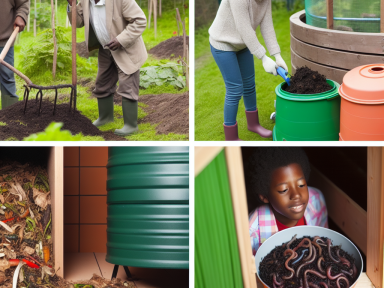Understanding Composting
Composting is a gardener’s alchemy, transforming kitchen scraps and garden waste into nutrient-rich gold for your plants. Here’s how to master this essential skill.
1. Choosing the Right Composting Method
There are several methods to choose from, depending on your space, needs, and dedication:
- Traditional Pile: Perfect for larger gardens. Simply pile your compostable materials in an open heap.
- Tumblers: Best for those with limited space. These enclosed bins make turning your compost easy.
- Vermicomposting: Ideal for small spaces and indoor composting. Let worms do the hard work!
2. What to Compost
Understanding what to compost is crucial for a healthy compost pile:
- Green Materials: These are rich in nitrogen. Examples include fruit and vegetable scraps, coffee grounds, and grass clippings.
- Brown Materials: These provide carbon. Incorporate leaves, straw, and cardboard.
Avoid composting meat, dairy, and oils, as they can attract pests and create unpleasant odors.
3. Balancing Greens and Browns
The key to successful composting is a balanced mix of green and brown materials. Aim for a ratio of roughly 1 part green to 3 parts brown. This ratio ensures that your compost heats up and breaks down efficiently.
4. Maintaining Your Compost
Maintaining your compost pile is essential for quick and efficient decomposition:
- Turn Regularly: Aerating your compost pile every few weeks accelerates the decomposition process by supplying oxygen.
- Moisture Levels: Ensure your compost is as moist as a wrung-out sponge. Too dry, and the decomposition stalls; too wet, and it can become a soggy, smelly mess.
5. Troubleshooting Common Problems
Even seasoned gardeners encounter issues with compost. Here are solutions to common problems:
- Odor Issues: Foul smells usually mean too much green material or improper turning. Add more browns and turn your pile.
- Pests: Surprisingly, adding meat or dairy can attract pests. Make sure to compost only plant materials and turn the pile regularly.
- Slow Decomposition: If your compost isn’t breaking down, it might be too dry, too wet, or lacking in nitrogen. Adjust water levels and add more greens.
6. Using Finished Compost
Finished compost is dark, crumbly, and smells like rich earth. Here’s how to use it:
- Garden Beds: Mix several inches into your soil to improve fertility and structure.
- Mulch: Spread it around plants to retain moisture and suppress weeds.
- Potting Mix: Blend with other ingredients to create a nutrient-rich potting mix for container plants.
Incorporate these composting basics into your gardening routine and you’ll see the rewards of your efforts in bountiful blooms and plentiful harvests. Happy composting!



GIPHY App Key not set. Please check settings